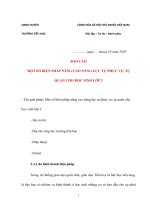STMGT101 Lecture 2 Working in teams
Bạn đang xem bản rút gọn của tài liệu. Xem và tải ngay bản đầy đủ của tài liệu tại đây (1.31 MB, 4 trang )
Working in teams
TEAMS & TEAM WORK
A team is a small group of people with complementary skills, who work together to accomplish shared
goals while holding themselves mutually accountable for performance results.
Teamwork is the process of people working together to accomplish these goals.
How do teams contribute to organizations?
• Individuals alone cannot achieve everything
• People need to learn how to work effectively in teams
• Managerial success is earned in substantial part through success at mobilizing, leading and supporting
high-performing teams
• New organizational designs and cultures require it
• A commitment to empowerment and employee involvement
Challenges of teamwork
FORMAL GROUPS – INFORMAL GROUPS
FORMAL GROUPS
• Teams officially recognized & supported by the
organization for specific purposes.
• They are part of the formal structure & are
created to fulfil essential operations.
INFORMAL GROUPS
• Independently formed to meet the social needs
of their members.
• interest groups
• friendship groups
• support groups
Marketing Research
Department Customer service team
Product assembly unit
Trends in the use of teams
Committees
• People outside their daily job assignments work together in a small team for a specific purpose.
• Task agenda is narrow, focused, and ongoing.
Projects teams or task forces
• People from various parts of an organization work together on common problems, but on a temporary
basis.
• Official tasks are very specific and time defined.
• Disbands after task is completed.
Cross-functional teams
• Members come from different functional units of an organization.
• Team works on a specific problem or task with the needs of the whole organization in mind.
• Teams are created to knock down “walls” separating departments.
Employee involvement teams
• Groups of workers who meet on a regular basis outside of their formal assignments.
• Have the goal of applying their expertise and attention to continuous improvement.
• Quality circles represent a common form of employee involvement teams.
Virtual teams
• A team of people who work together and solve problems largely through computer-based rather than
face-to-face interactions.
• Among the many developments, the sophistication of networking technologies and groupware
programs is highly significant.
• Advantages: save time & travel expenses; allow members to work collectively in a time-efficient way,
easily expanded to include additional experts, and the discussions and information shared among team
members can be stored online for continuous updating and access.
• Relations among team members can become depersonalised as the lack of face-to-face interaction
limits the role of emotions and non-verbal cues in the communication process.
Members join & begin the
process of defining group’s
purpose, structure,
leadership.
A fully functional group
structure allows the group
to focus on performing the
task at hand.
Close relationships
develop as group becomes
cohesive & establishes its
norms for acceptable
behavior.
Group conflict occurs as
individuals resist control
by the group & disagree
over leadership.
Characteristics of Effective Teams
The group prepares to
disband and is no longer
concerned with high levels
of performance.
• Have a clear understanding of their goals.
• Have competent members with relevant technical and interpersonal skills.
• Exhibit high mutual trust in the character and integrity of their members.
• Are unified in their commitment to team goals.
• Have good communication systems.
• Possess effective negotiating skills
• Have appropriate leadership
• Have both internally and externally supportive environments
SUMMARY AND CONCLUSION
• Work is becoming more complex, which requires a group or team effort
• Teams are groups where members with complementary skills hold themselves mutually accountable
for team performance
• Building effective groups and teams requires knowledge of task/technology, people, formal
organization arrangements and group culture







